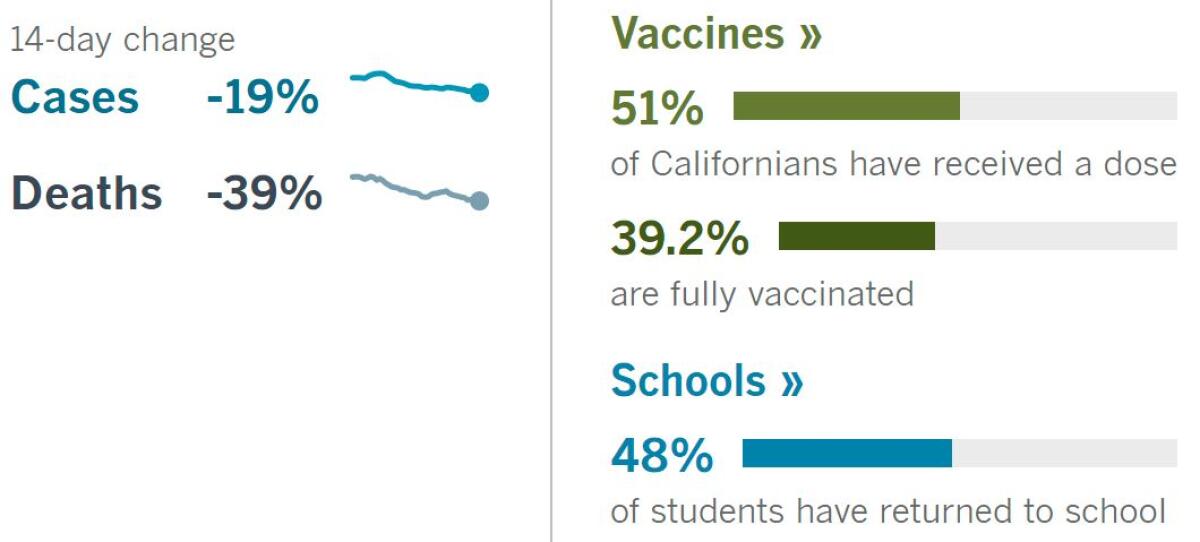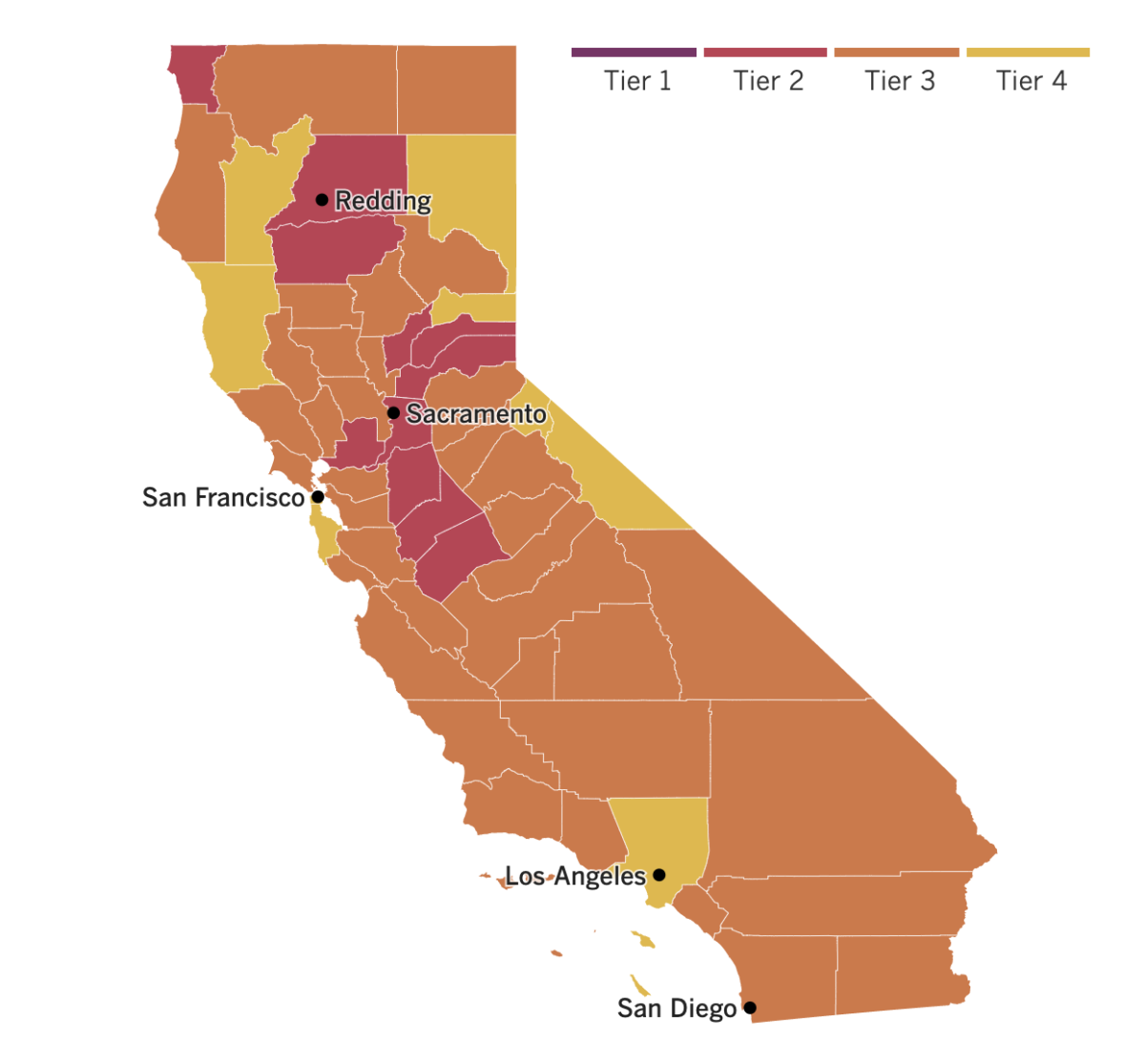Coronavirus Today: Kids’ new ticket to freedom
- Share via
Good evening. I’m Kiera Feldman, and it’s Monday, May 17. Here’s what’s happening with the coronavirus in California and beyond.
For many parents in California and elsewhere, the high point of the weekend involved doing something they’d been eagerly anticipating for months: getting their older children vaccinated against COVID-19.
Some parents brought their kids to drug stores or medical offices right after school got out on Friday to kick off the weekend with a shot. Others went on Saturday or Sunday, proudly posting Facebook pictures of their eye-rolling adolescents who’ve learned to tolerate the excesses of parental social media.
Downtown L.A. resident Ginny Brideau secured an appointment for her 12-year-old daughter to get vaccinated at a Ralphs on Monday. She can barely contain her excitement.
“Being able to go out [to the] movies, library, grocery store, see good friends, get to church — it will be a good thing,” Brideau told my colleague Hayley Smith.
Studio City parent DJ Jenkins offered another reason why he was eager for his daughter to receive her first dose this Friday — right on her 12th birthday.
“Being vaccinated, we’re helping to stop the spread and therefore protecting the most vulnerable among us,” Jenkins said.
About 2.1 million Californians are between the ages of 12 and 15, including roughly half a million in Los Angeles County. They became eligible for the COVID-19 vaccine on Thursday, and getting them immunized will be key to reducing the spread of the virus in the community, experts say.
But parents will be the rate-limiting factor, and some aren’t ready to trust the vaccine.
“There is no reason we should require or expect our children to take experimental drugs whose long-term effects are unknown,” said Ronni Peck, a mother of three who lives in Sun Valley and hasn’t gotten the vaccine for herself either. “If long-term studies in the next few years deem the COVID vaccines truly safe, then I may reconsider both for myself and my children.”
Dr. Eric Ball, a pediatrician at Children’s Hospital of Orange County Primary Care Network, said he has been assuring hesitant parents that the vaccine is “remarkably effective and very safe,” noting that tens of millions of Americans have already been vaccinated without severe reactions.
On the other hand, COVID-19 can cause serious health problems, even in children. Ball said he has had to hospitalize about half a dozen young COVID-19 patients, including one who almost died of multisystem inflammatory syndrome in children, or MIS-C.
“Most kids are fine, but you never know if you’re going to be the one kid who ends up with a horrible outcome,” Ball said. “It’s much safer to get the vaccine than to roll the dice with COVID.”
A recent Kaiser Family Foundation poll found that nearly a quarter of U.S. parents who have at least one child from the ages of 12 to 15 said they will “definitely not get their child vaccinated.” A little more than a quarter said they will wait to see how it’s working. And 18% said they will vaccinate only if their child’s school requires it.
Vaccinating adolescents will soon be easier than ever. Starting May 24, L.A. Unified will roll out an ambitious new COVID-19 vaccine effort at 250 schools. It’s part of a campaign to get shots into the arms of 12- to 15-year-old students before the summer break begins, Supt. Austin Beutner announced Monday.
“We want to start vaccinating students during this school year while teachers, staff and students are still in schools,” Beutner said. “Educators can share information with families and help encourage students to get vaccinated. Schools can empower student voices to speak about this opportunity with their peers.”
If it works, it will pave the way for a fall semester in which as many children as possible will have maximum protection from COVID-19. That could help convince parents it’s safe to send their kids back to campus. As of last week, only about 30% of elementary school students have returned to their classrooms, along with 12% of middle school students and 7% of high schoolers.
Health concerns remain a major factor in family hesitancy to return. But the strategy’s success will depend on whether parents will give their blessing to the vaccine.
By the numbers
California cases, deaths and vaccinations as of 6:25 p.m. Monday:

Track California’s coronavirus spread and vaccination efforts — including the latest numbers and how they break down — with our graphics.

Across California
People in other parts of the country may be rejoicing over the new federal guidance on face masks, but California will wait to adopt new mask rules until June 15, the day the state is slated to reopen its economy, state officials announced Monday.
When that day comes, people who are fully vaccinated will be able to go mask-free in most indoor settings. The change will bring the state into alignment with the Centers for Disease Control and Prevention’s latest advice, which says it’s safe for fully vaccinated people to go without masks in most places, whether outdoors or inside.
That was only a recommendation, though, and the final call on masks was largely left to state and local governments. (One exception is that masks will still be required on public transportation, such as trains, buses and airplanes, as well as at airports and other transit hubs.)
State officials said that keeping the current mask rules in place another month will give Californians more time to get vaccinated, and give businesses and workers time to prepare for the change.
“It’s in no way saying that the science or the direction by the CDC is wrong or there’s a challenge to it,” said Dr. Mark Ghaly, California’s health secretary. “It’s really just giving ourselves across the state some additional time to have it implemented with a high degree of integrity, with a continued focus on protecting the public.”
Ghaly may not be questioning the substance of the new CDC guidance, but many others are. Experts in California and across the country pushed back over the weekend, saying they planned to keep their masks on a bit longer to stay on the safe side for now.
“I strongly recommend to others that when at an indoor place where both vaccinated and unvaccinated people mix, such as grocery stores, that they wear a mask too,” tweeted Dr. Carlos del Rio, infectious diseases expert at Emory School of Medicine in Atlanta.
Dr. Ashish Jha, dean of the Brown University School of Public Health, agreed in a tweet: “Here’s my personal practice for now: Continue indoor masking in public places like grocery stores until more are vaccinated, infection numbers are down.”
Some experts warned that relaxing mask rules now could set a bad precedent. They worry that unvaccinated people will defy the rules and go unmasked, increasing the risk of coronavirus transmission and potentially putting vulnerable groups — such as children too young to be vaccinated or immune-compromised people — at greater risk.
That feeling is shared by regular folks, some of whom found themselves shopping inside stores that went ahead and told customers that if they were fully vaccinated, they could ditch their masks.
“I don’t think we’re far enough into vaccinations to stop wearing masks, and there’s nothing that Trader Joe’s is doing to check if maskless shoppers are unvaccinated or not,” said Jack Robb, a fully vaccinated 72-year-old from Alhambra who wore two masks when he visited the grocery store’s South Pasadena location.
A sign in front of the store said, “In accordance with CDC guidelines, customers who are fully vaccinated are no longer required to wear masks while shopping in our stores.”
Ana Mejia, 67, a Highland Park resident and shopper who stopped by for a bouquet of tulips and broccolini, wasn’t impressed with the sign either.
“This is irresponsible and too soon,” she said. “So many people are trying their best to stop this disease by masking and social distancing, and we’re not done.”
But we’re getting close. More than 50% of California residents — roughly 19.6 million people — have received at least one dose of a COVID-19 vaccine, according to a Times analysis. About 38% of California residents are fully vaccinated.
California ranks 12th nationwide in terms of the percentage of residents who’ve gotten at least one dose, according to the U.S. Centers for Disease Control and Prevention.
In early April, California averaged 400,000 doses a day. Since then, the pace of vaccinations has dropped to roughly 250,000 doses per day. To get more people vaccinated, officials in some parts of California are shuttering mass vaccination sites and devoting more resources to mobile and pop-up clinics that can offer easier access to the shots in some of the state’s hardest-hit neighborhoods.


See the latest on California’s coronavirus closures and reopenings, and the metrics that inform them, with our tracker.
Consider subscribing to the Los Angeles Times
Your support helps us deliver the news that matters most. Become a subscriber.
Around the nation and the world
The pandemic has prompted America to take a long look in the mirror, and Dr. Anthony Fauci doesn’t like everything he sees.
Addressing the graduating Class of 2021 at Emory University on Sunday, the nation’s top infectious disease doctor said that “the undeniable effects or racism” have led to unacceptable health disparities that have hurt African Americans, Latinos and Native Americans during the pandemic.
People of color made up the bulk of the workforce performing essential jobs during the pandemic, and that means they bore the brunt of coronavirus exposure each day, Fauci said. And that’s on top of longstanding health disparities that made them more vulnerable to a serious case of COVID-19 as a result of underlying medical conditions such as hypertension, chronic lung disease, diabetes or obesity.
“COVID-19 has shone a bright light on our own society’s failings,” he said. He warned the graduating seniors not to forget about these problems once society returns to “some form of normality” and urged them to become part of the solution — one that will take decades to realize.
Another problem with U.S. healthcare system that the pandemic has brought to the fore is the way it prioritizes expensive interventions over preventative care, Dr. Robert Pearl, former chief executive of the Permanente Medical Group, argues in an op-ed.
Two-thirds of patients hospitalized with COVID-19 suffered from at least one chronic disease, such as diabetes, hypertension and heart failure, according to the National Institutes of Health. Critical care doctors treated these patients at hospitals, Pearl notes. But if American physicians had dedicated more time and effort toward preventing and better managing chronic diseases, tens of thousands of people wouldn’t have needed to be hospitalized with COVID-19 in the first place.
What we have now is a system in which doctors benefit economically at the expense of patients, Pearl says. Doctors order unnecessary tests, overprescribe medications and perform risky surgeries when less-expensive approaches would be just as valuable.
Preventing disease isn’t as visibly “heroic” as pulling off a lifesaving intervention, Pearl argues. But who wouldn’t prefer to be healthy than to be saved by a dramatic double-bypass operation? Medical schools and the broader medical culture “must elevate the esteem of primary care, make clear its crucial role,” he writes.
In other news, Sanofi and GlaxoSmithKline announced promising results Monday from early trials of their COVID-19 vaccine. That boosted hopes that the experimental shot could join the fight against the pandemic this year.
After two doses of the vaccine, participants in the Phase 2 trial had neutralizing antibodies on par with those found in people who had recovered from a real-life case of COVID-19. The drugmakers said they plan to begin late-stage trials in the coming weeks and hope to win regulatory approval for the vaccine before the end of 2021. About a dozen other vaccines are currently undergoing late-stage trials.
Public health experts say multiple vaccines will be needed to meet the challenges of producing and distributing enough doses to vaccinate billions of people.
Unfortunately, there will never be a vaccine for the plague that is online coronavirus misinformation campaigns.
People all over the country have had their online posts hijacked by anti-vaccine activists and others peddling lies about the pandemic. Among them is Dr. Michelle Rockwell, who posted to Instagram about her pregnancy loss. To her horror, social media users began using that and other posts of hers to spread the false claim that the COVID-19 vaccine caused her miscarriage.
Sharing other people’s online posts out of context is a common tactic in the disinformation playbook because it’s an “easy, cheap way to gain credibility,” said Lisa Fazio, a Vanderbilt University psychology professor.
“A Cornell professor warning about COVID, that’s boring. The same professor saying COVID is a hoax, well, that’s interesting and guarantees traffic,” said Dr. Elias Aboujaoude, a psychiatrist and Stanford University professor who studies the intersection of psychology and technology.
Your questions answered
Today’s question comes from readers who want to know: How do you persuade someone who’s reluctant to get vaccinated to go ahead and do it?
These days, you can walk into pharmacies and vaccination sites around L.A. and get a dose without an appointment. But just because it’s easy doesn’t mean people will do it.
If your friend, neighbor, coworker or loved one hasn’t gotten their COVID-19 vaccine yet, they probably have a reason, my colleague Jessica Roy writes in this helpful explainer. Identifying that reason is key to convincing them to get their shot, experts say.
The ground rules: Don’t debate. Listen to what they say. Really try to understand where they’re coming from and why they’re concerned. If you want them to get vaccinated, you’ll never succeed if you’re trying to argue them into it.
“We have to meet people where they are, so we have to actually hear where they are first,” said Dr. Chandra Ford, a professor of community health sciences at UCLA Fielding School of Public Health.
That means your first step is to ask the all-important question: “Why aren’t you vaccinated?”
Reservations are probably based in both logic (Is the vaccine really safe? How were the shots developed so quickly? How can we be sure there won’t be long-term side effects?) and emotion (fear, anxiety, frustration, anger). You need to enter the conversation prepared to address concerns on both fronts.
You also have to find out what sources of information the person trusts.
“To address hesitancy, people have to hear those local, personal and relatable stories about vaccinations, and how it benefits not just themselves, but how it’s benefiting others around them in their community,” explained Courtney Gray Haupt, who runs the U.S. healthcare team at Edelman, a communications firm.
It may behoove you to get a sense of what people value and what role a vaccine could play in their lives. For some, getting vaccinated can mean being able to hug your parents again, or hold a grandchild for the first time. For others, it means freedom to travel to other countries.
If someone is worried about the side effects of the vaccines, compare them with the consequences of getting COVID-19.
Dr. Rita Burke, an assistant professor of clinical preventive medicine at USC Keck School of Medicine, said the chief concern she‘s heard was about the vaccines’ safety.
“In that case, it’s really important to explain to the person that the technology that’s enabled us to develop a vaccine so quickly has been in place and was in development many, many years ago,” she said in an interview with The Times. “So the safety of the vaccine was in no way compromised in order to deliver it so quickly.”
If the person lives in an alternate reality filled with conspiracy theories, remember that it could well take more than one conversation to make any headway.
“Keep your expectations modest,” Lonnie G. Bunch III, the secretary of the Smithsonian, advised on Twitter. “Set an achievable goal, such as opening the topic, not changing minds in one chat.”
We want to hear from you. Email us your coronavirus questions, and we’ll do our best to answer them. Wondering if your question’s already been answered? Check out our archive here.
Resources
Need a vaccine? Sign up for email updates, and make an appointment where you live: City of Los Angeles | Los Angeles County | Kern County | Orange County | Riverside County | San Bernardino County | San Diego County | San Luis Obispo County | Santa Barbara County | Ventura County
Need more vaccine help? Talk to your healthcare provider. Call the state’s COVID-19 hotline at (833) 422-4255. And consult our county-by-county guides to getting vaccinated.
Practice social distancing using these tips, and wear a mask or two.
Watch for symptoms such as fever, cough, shortness of breath, chills, shaking with chills, muscle pain, headache, sore throat and loss of taste or smell. Here’s what to look for and when.
Need to get tested? Here’s where you can in L.A. County and around California.
Americans are hurting in many ways. We have advice for helping kids cope, resources for people experiencing domestic abuse and a newsletter to help you make ends meet.
We’ve answered hundreds of readers’ questions. Explore them in our archive here.
For our most up-to-date coverage, visit our homepage and our Health section, get our breaking news alerts, and follow us on Twitter and Instagram.




